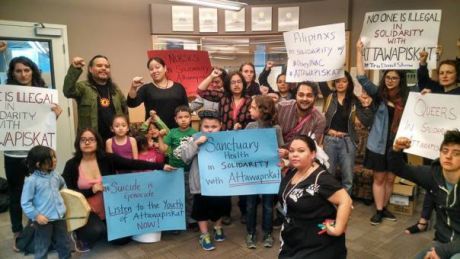News
You are here
INAC occupations: solidarity with Attawapiskat

May 1, 2016
Last week Council of Mothers ended their occupation of the Vancouver office of Indian and Northern Affairs Canada (INAC), after winning a meeting with Ministers of Indigenous and Northern Affairs and Minister of Canadian Heritage to discuss their demands. This came after a wave of occupations across the country in solidarity with Attawapiskat youth, which began in the wake of Black Lives Matter-Toronto occupation in front of police headquarters.
These occupations has brought to the forefront the ever present and increasingly detrimental colonial conditions that plague Indigenous communities in North America, as well as highlighting the strength and importance of solidarity between movements.
Crises near a diamond mine
The INAC occupations came in response to various crises that the Attawapiskat community in Northern Ontario has been experiencing, most notably endemic suicide and the housing crisis.
In the past seven months alone, there have been over one hundred suicide attempts, with eleven occurring in only one day, on April 9, 2016.
As the statement from the occupied INAC office in Winnipeg explained, “These crises are not new and do not exist in isolation. Suicide has long plagued our communities due to centuries of colonization and its effects: crushing poverty, substandard housing, imprisonment, child apprehension, and lack of access to health care, nutrition and clean water. The resulting destruction of identity, lack of self worth and cognitive imperialism are the roots of suicide in our people. This issue is inseparable from the epidemic of Missing and Murdered Indigenous Women; the legacy of residential schools; the 11,000 and counting children in care in Manitoba; and the theft, pollution, and exploitation of the land, water, and air. The violence perpetrated against nature reflects the violence perpetrated against our women, our men, and our youth.”
This comes in sharp contrast to the conditions of multi-billion dollar businesses operating in the area. The Victor mine, located 90 km west of Attawapiskat and owned by the De Beers diamond company, is flourishing. The mine is on traditional Attawapiskat land, but vested into the hands of the Canadian government through the 1930 extension to Treaty 9. As such, the company is not legally mandated to provide any royalties to the First Nation, nor many to the Canadian government either—while the mine made $400 million in 2014, De Beers paid less than $300 in royalties.
Occupations and solidarity
When news broke about the suicide crisis, Indigenous activists and allies occupied the INAC offices in downtown Toronto, from April 12 to 21. This came only a few weeks after the BLMTO organized a two-week “tent city” occupation outside police headquarters, after the Special Investigations Unit cleared and kept secret the police officers who killed Andrew Loku.
Though these occupations were separate, and rallying around perceivably different issues, it is important to note the links that brought these two actions together, and that in the end, helped the movements gain recognition. From the very first night members of the Indigenous community joined in and supported the BLMTO protest not only with songs, smudging and prayers but also with their own bodies. When the tragedy of Attawapiskat emerged, and the people of Toronto took to the offices, one of the prominent voices of solidarity came from the BLMTO protesters who had themselves just made it out of their own occupation. Through the process, this mutual solidarity strengthened both movements and challenged their common oppressor: the Canadian state, built on colonialism and slavery.
Cree lawyer Tanya Kappo told CBC this of the INAC occupations in Toronto: “The occupation, in my mind, became a great sign of support to people in Attawapiskat… This is a way of getting the message out there in a peaceful way, that comes from a place of support and caring.”
The youth in the Attawapiskat community are calling for a list of demands that they have presented to the Canadian government. It includes such things as a youth centre, better education, sporting equipment, and overall the bare minimums of community resources. This has been largely ignored. Instead, the most recent activity of the Canadian government in regards to this issue has been sending mental health counsellors to the community, and a Tweet from Justin Trudeau promising better living conditions for the First Nations peoples.
As Grand Chief Stewart Phillip, president of the Union of BC Indian Chiefs said, “The Council of Mothers have said that they are not prepared to wait for the government to take four years to act on these issues. They are demanding action right now, and I would suggest to the Trudeau government, and to the court government that if action is not taken, if the Council of Mothers are not listened to, what you witnessed in the last week will become the hallmark, that characterizes the relationship between Aboriginal peoples in this country, and the Trudeau government, and the Provincial governments across this country regardless of their public attitudes and statements of good intention… This could be the beginning of a long and hard summer across this country, with respect to the multitude of issues that confront Aboriginal peoples in this country that have been going on for far too long.”
Section:
Topics:










